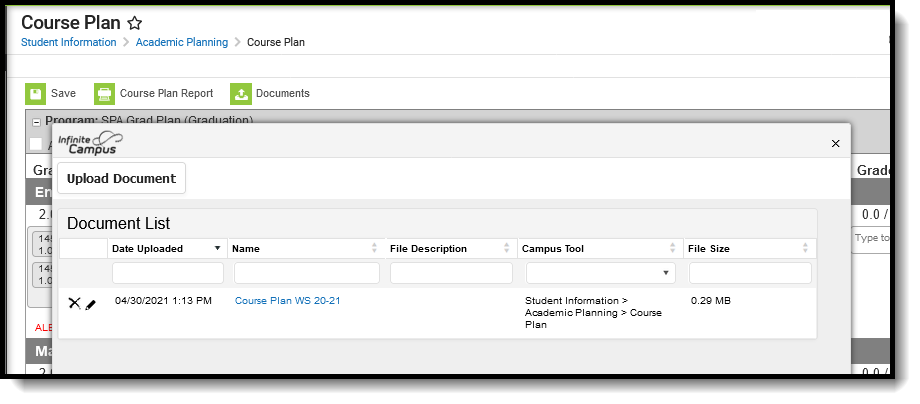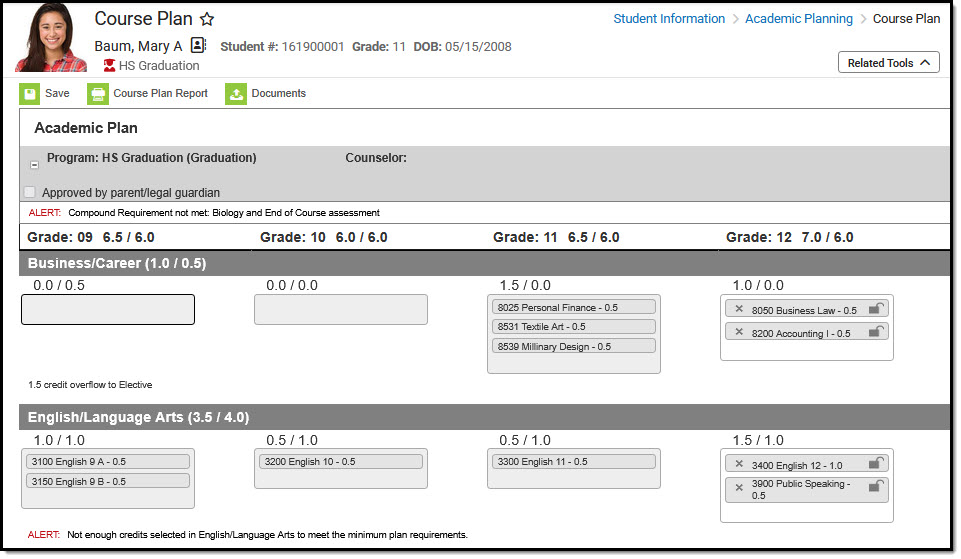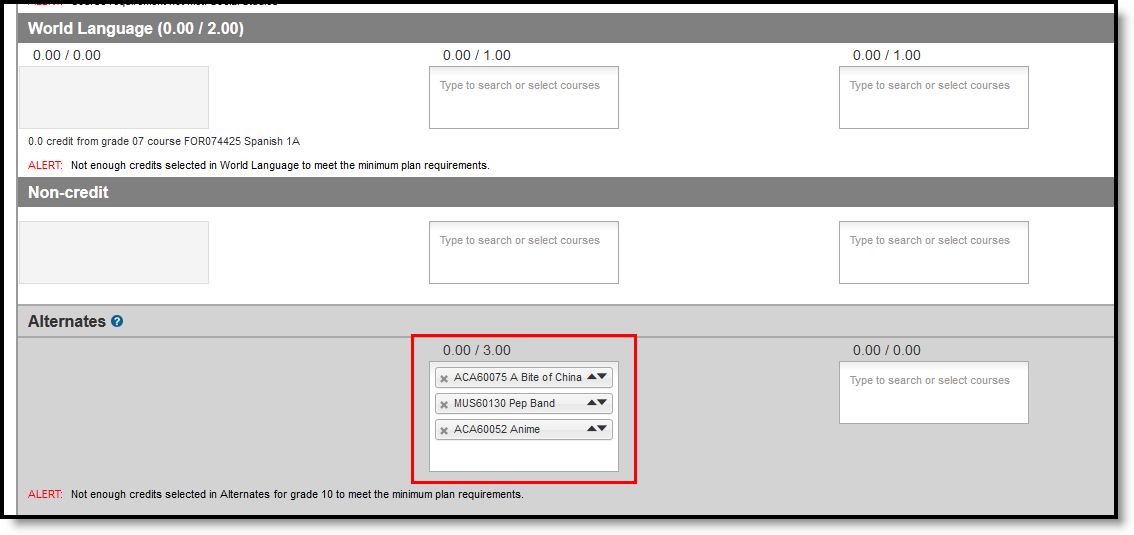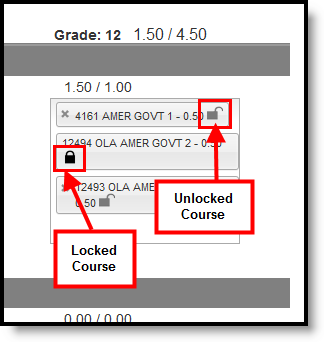Tool Search: Course Plan
The Course Plan tool displays the student's assigned Graduation Program and any assigned Academic Programs, as well as the courses the student has planned to take in each school year (represented by grade level). Staff use this tool to manage a student's Course Plan.
Students can add courses to their Course Plan in Campus Student by using the Academic Plan tool.
See the Course Plan (Academic Planning) Tool Rights article for information about rights needed to use this tool.
Academic and Graduation Program Assignments
 Academic and Graduation Program Assignments
Academic and Graduation Program AssignmentsThe collapsible Course Plan header lists the programs to which a student is assigned.
A student's assignment to Academic and Graduation Programs can be changed, if appropriate, during their high school career. This does not impact credits earned, but may require updating of the student's course plan to ensure that program requirements are met.
Each student:
- Can only be assigned to one Graduation Program
- Does not have to be assigned to an Academic Program
- May be assigned to multiple Academic Programs
Middle school grade levels only display if the student has earned high school credit in middle school courses.
Add Courses to a Plan
A student must be assigned an Academic Program in order to use the Course Plan. The assigned program must have course requirements in order for courses to be added to the plan. A message displays if the assigned program does not have any credit requirements. Course requirements can be added after Credit Requirements have been defined for the selected plan.
 Add Courses to Course Plan
Add Courses to Course Plan
Editing of the Course Plan for the current or a past grade level is disabled when at least one course is scheduled for the student.
The Course Plan displays the Credit Types and how many credits of each type are planned vs. required to be earned at each grade level of the assigned Graduation Plan.
- Click the field corresponding to a credit type and grade level, for example Grade 10 Business/Career. Courses meeting that credit type display in a dropdown list. You may also choose to search for a specific course or course number.
- Select the desired course(s). The selected courses display in the field and the planned vs. required number of credits updates. The credits assigned to a course appear after the course name.
- Add enough credits for future years as needed. When the student has met the number of requirements, the alert that displays for each credit type stating not enough credits are selected disappears.
- Repeat these steps for each credit type. At the end of the process, the student should have a clear idea of what courses he will be taking in each grade level.
- Click the Save icon when finished. An confirmation appears that also serves as a notification when there are plan requirements that have not been met.
 Course Plan - Alert on Save
Course Plan - Alert on SaveAdd Alternate Courses to a Plan
Students and counselors can enter alternative courses to take in the event the student cannot be scheduled into desired courses.
In order to add alternate courses to a plan, the Graduation Program must be marked to allow the planning of alternate courses. Planning rules assigned at the course level are followed when planning alternates. If the Graduation Program is not marked to allow alternates, the Alternates panel will not display at the bottom of the Course Plan.
See the Academic and Graduation Programs: Graduation Program Setup article to learn how to do this.
Alternate courses are added the same way as other courses.
- Under Alternates, Click the field corresponding to the grade level for which you wish to add alternate courses. Available courses display in a dropdown list. You may also choose to search for a specific course or course number.
- Select the desired course(s).
- Use the arrows to move the courses into the desired order in which an administrator or counselor should try to place the student in the even they cannot be scheduled into non-alternate courses.
The Scheduling Board does not schedule students into Alternate courses. Alternate course requests display with a Type of "A" in the Walk-In Scheduler, in the order in which they are saved on the Course Plan, so staff know the preferred order in which they should attempt to manually schedule a student into their alternate requests.
Note the following:
- Alternate courses can only be planned for future years. A current year freshman student can only plan alternates for the sophomore, junior and senior years.
- If a course is already planned as a desired course, it cannot be planned as an alternate in the same year it is planned. It can be added as an alternate in a different year.
- Courses planned as alternates do not satisfy planning rules. If an alternate course is planned and it violates a planning rule, the course is included in the list of alerts.
- Counselors cannot lock or unlock alternate courses.
- Courses that are part of a compound requirement display in bold in the selection area when a Grade Level is specified or is marked as Recommended in Course Requirements.
Lock Courses on a Plan
Courses required for graduation should be locked. When students create their course plan on the Portal, the counselor can review the plan, make changes if needed, and lock the appropriate courses.
Any courses that are unlocked can be changed by either the counselor or the student.
- To lock a course, click the opened padlock icon by the course. This changes the image to a locked padlock and indicates the course cannot be removed from the plan.
- To unlock a course, click the locked padlock icon by the course. This changes the image to an unlocked padlock and indicates the course can be removed from the plan.
Parent/Guardian Approval
Schools may wish parents to review and approve course plans students build in the Portal to help ensure the student is taking the correct courses in the correct time frame with the adequate amount of credits in a certain term, with a desired amount of rigor and challenge.
Counselors can see that the parent/guardian has approved the plan from the Course Plan tool. If the student or counselor makes changes to the plan after the parent/guardian has marked the checkbox, that checkbox does not reset. This is a read-only field for the counselor and can only be removed when using the Course Plan Admin tool.
Note the following:
- An independent student (emancipated minor) cannot sign for themselves.
- A parent can mark the approved checkbox without the plan being completed.
- A parent can mark the approved checkbox but cannot save if the plan has errors.
Course Plan Report
The course plan report displays the student's current plan, including alternates. Alerts, warnings, and errors are not included.

A warning displays when generating this report if changes to the Course Plan have not been saved. To generate the Course Plan Report:
- Select the Course Plan Report icon
- Choose the Report Format (PDF or DOCX)
- Click Generate Report.
Note the following:
- When a course is assigned the "parent of/child of" course planning rule, the Course Plan report lists all of the courses associated with that rule (parent and child courses). It also lists the correct credit value, total credit value per credit type and per grade level for all of the courses.
- The report includes in-progress courses, planned non-credit courses, and current year planned courses. Grading task credits not associated with the student's program are not displayed. This means courses that provide multiple types of credit do not display on the report.
- This report can be generated for multiple students using the Course Plan Batch Report.
Documents
To view documents, click the Documents button on the action bar. See the Student Person Documents article for more information.
 Course Plan Documents
Course Plan Documents



